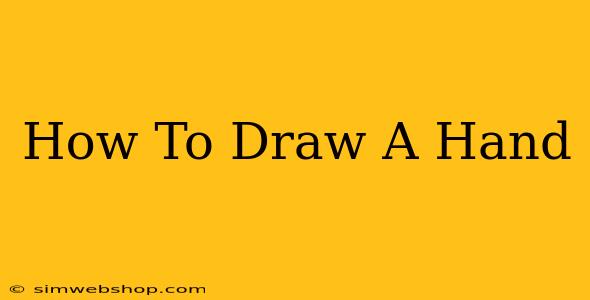Drawing hands can seem daunting, but with a little practice and the right techniques, you can master this challenging yet rewarding aspect of figure drawing. This guide provides a step-by-step approach, perfect for beginners and those looking to improve their hand-drawing skills. We'll cover various hand positions and offer tips for achieving realistic results.
Understanding Hand Anatomy: The Foundation of Realistic Drawing
Before diving into the drawing process, understanding the basic anatomy of a hand is crucial. This will help you create more realistic and believable hand drawings.
Key Components:
- Palm: The fleshy base of your hand. Observe its shape and how it curves.
- Fingers: Note the varying lengths and thicknesses of each finger. The thumb is unique and highly mobile.
- Knuckles: These are the joints connecting each finger bone. Pay attention to their placement and how they protrude.
- Wrist: The connection point between the hand and forearm. Its shape influences the overall pose of the hand.
Step-by-Step Guide to Drawing a Hand
Let's start with a simple, relaxed hand position.
Step 1: The Basic Shape
Begin by sketching a simple, overall shape that resembles the hand's general form. Think of a slightly elongated oval or a flattish egg shape for the palm. Don't worry about details at this stage; just capture the essence of the hand's posture.
Step 2: Blocking Out the Fingers
From the basic shape, lightly sketch in the fingers. Think of them as simple cylinders or slightly tapered rectangles. Don't worry about perfect proportions yet; focus on the overall arrangement and relative lengths of each finger.
Step 3: Defining Knuckles and Joints
Once you have the finger shapes, add the knuckles. These are crucial for creating a realistic look. Lightly sketch circles or slightly elongated ovals to represent the knuckles, paying attention to their position and alignment.
Step 4: Adding Detail and Refining Shapes
Now it's time to refine the shapes. Pay attention to the subtle curves and contours of each finger and the palm. Erase any unnecessary lines and strengthen the ones that define the hand's form.
Step 5: Shading and Value
To add depth and realism, incorporate shading. Observe where light falls on the hand and where shadows form. Use shading to create volume and a three-dimensional effect. Pay particular attention to the creases and folds in the skin.
Drawing Hands in Different Positions
The same basic principles apply to drawing hands in various positions, but the initial blocking-out stage will differ. Here are a few examples:
- Clenched Fist: Start with a rough sphere for the overall shape, then add the compressed fingers.
- Open Hand (Palm Up): Begin with a flat, slightly curved shape for the palm, and extend the fingers from there.
- Pointing Finger: Focus on the extended finger and how it interacts with the rest of the hand.
Tips for Success:
- Use References: Use photos or real-life models to observe hand shapes and positions.
- Practice Regularly: Consistent practice is key to improving your drawing skills.
- Start Simple: Don't try to tackle complex poses immediately. Master the basics before moving on to more challenging subjects.
- Don't Be Afraid to Erase: Mistakes are part of the learning process. Don't be afraid to erase and redraw until you're satisfied with your results.
- Experiment with Different Mediums: Try drawing hands using pencils, charcoal, pens, or even digital tools to discover your preferred style.
Drawing hands is a journey, not a destination. With patience, practice, and a keen eye for detail, you'll steadily improve your ability to capture the beauty and complexity of the human hand. Keep practicing, and you'll be amazed by your progress!

